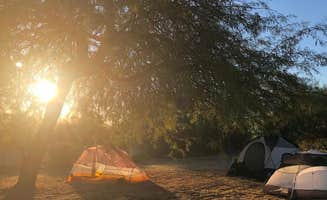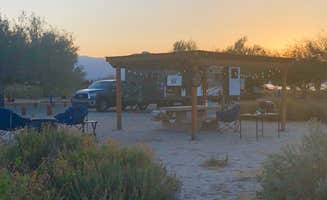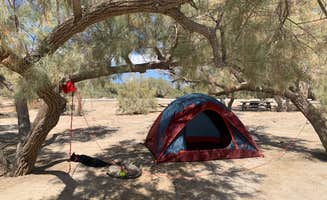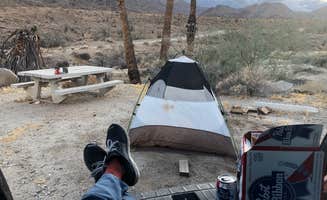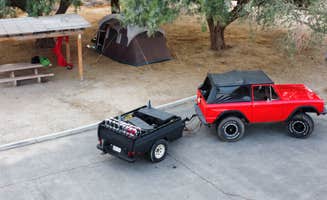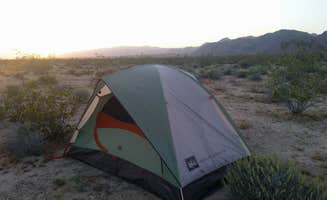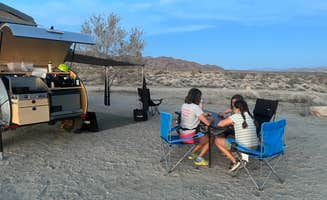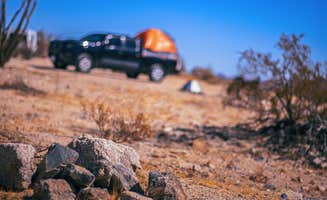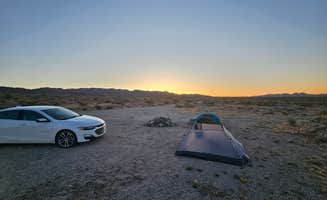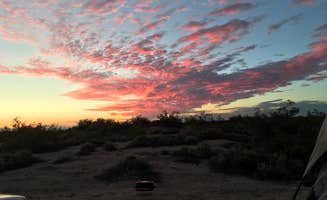Camping areas surrounding Niland, California sit at approximately 130 feet below sea level in the Imperial Valley's harsh desert terrain. Winter temperatures average 65-75°F while summer heat regularly exceeds 110°F, making October through April the primary camping season. The region borders the shrinking Salton Sea, creating a unique landscape where both established campgrounds and primitive desert sites offer contrasting camping experiences.
What to do
Visit Bombay Beach art installations: Located along the Salton Sea, the nearly abandoned town has become an artistic hub. "This place is so so special, beautiful, and a bit extreme. I'd consider this less of a place for recreational camping and more an alternative lifestyle safe place," notes a visitor to Bombay Beach - Salton Sea State Rec Area. Another camper shares, "The town and the beach are just so... interesting. The artists are taking over the nearly abandoned town and it's really neat to see."
Soak in desert hot springs: The natural hot springs provide relaxation after desert exploration. "What an amazing place with friendly staff. The bathrooms and showers are very clean and the hot springs tubs are nice and comfortable," reports a visitor to Glamis North Hot Springs Resort. The resort offers both hot spring pools and cold pools for alternating soaks.
Explore community libraries: Slab City maintains a community library where visitors can check on special events. A camper at Slab City advises, "I give it a 4 for the unique experience and urge you to check into the 'library' if you make it there. They will let you know if you have arrived during any special occasions such as their community prom or karaoke night at their nomadic bar."
What campers like
Community gatherings: Many campers appreciate the social aspects of established camps. At Mojos Slab Camp, visitors note the welcoming atmosphere: "Lots of interesting people to talk to, it's a very community oriented camp so plan to make some friends while you are there! We sat by the fire morning and night with the crew there and got to hear some amazing stories."
Winter weather conditions: The mild winter temperatures make camping pleasant during cooler months. A camper at Red Hill Marina Park states, "Very Primitive location but beautiful in its own right. Gets dusty, tons of birds, close to the Salton Sea and no complaints. $7 per night for a tent site, a little more for hookups. $2 day use fee."
Wildlife viewing: Bird watching opportunities abound, particularly near the Salton Sea. "Great spot all to ourselves near the Sultan Sea. Sunset was beautiful," mentions one camper, while another notes that "Major plus is birding at the Salton Sea National Wildlife Refuge."
What you should know
Water availability varies dramatically: Most dispersed sites have no water access. A visitor to Joshua Tree South - BLM Dispersed advises, "There are no hookups or facilities, and it's pack it in, pack it out. There is a Chevron station just a short drive away (via either the freeway or dirt trails) that has bathrooms and all the basics in case you forgot something at home."
Sand hazards for vehicles: Many areas have soft sand that can trap vehicles. One camper warns, "Nice area, open enough you don't need to worry about interacting with or bothering your neighbors if you don't want to. Just be careful of the sandy areas, got dug in with my sprinter and needed someone to pull me out."
Seasonal insect populations: Mosquitoes and flies can be intense, particularly near water. A visitor to Finney Lake Camp reports, "Pretty lake, but swarming with flies and a bit of an odor," while another camper mentions, "Great spot all to ourselves near the Sultan Sea. Sunset was beautiful, the smell was a bit strong off the sea, but then the mosquitos came and they were brutal!"
Tips for camping with families
Research community atmosphere: Some camping areas have established rules while others function as alternative communities. A visitor to Fountain of Youth Spa RV Resort shares, "I've spent many weekends at this resort over the last 15 years or so, visiting my grandparents that lived here in the winter. Tons of activities, clean and quiet, such a wonderful spot!"
Pack extra water supplies: Desert conditions require significant hydration. "This is more than just DISPERSED camping where you pull over and kick back. Its literally survival at all times because that's what THEY are doing in the desert," warns one camper about Slab City.
Consider cabins for summer visits: Temperatures regularly exceed 110°F in summer months. "They also rent wagon cabins that look great. Full hook ups," notes a visitor about accommodation options that provide protection from extreme heat at Glamis North Hot Springs Resort.
Tips from RVers
Secure reliable hookups: Many areas lack electricity and water connections. A camper staying at Niland Marina reports, "Beautiful spot near the lake with gorgeous views. Nobody as far as the eye could see, of course it's 100 degrees, but I have a trailer and awning with netting."
Check road conditions: Many access roads are unpaved and can become difficult to navigate. "A little tricky for my 2wd in some spots. Plenty of room to roam and space out if you'd like," shares a visitor about Joshua Tree South dispersed camping.
Maintain power independence: Most dispersed camping areas have no electrical hookups. One visitor to Slab City explains, "We had our inverter generator for power. Had great cell phone coverage 5g signal. Was able to stream on our TV with roku."


